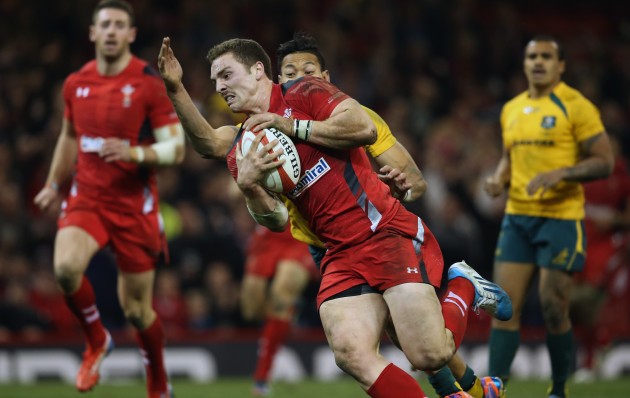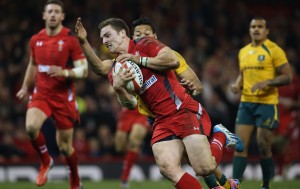
Struggling to come to terms with the loss: Wales have now lost nine of their last Test matches against Australia
By Paul Williams
We’ve been here before
I was tempted to save myself a bit of work this week by cutting and pasting the opening paragraph from my previous six Wales v Australia articles. Yet again Wales lost by a narrow margin in a thoroughly engaging encounter.
Wales were defeated 26 – 30, which is a point differential of 13%. This neatly sums up the difference between the two teams. With the exception of the Wales’ defence, Australia were 10% to 15% better in most aspects of the game. Wales secured 48% of the possession and 43% of the territory. And whilst both teams’ lineouts struggled to deliver clean possession it is fair to say the Welsh lineout had bigger issues with a completion of only 69.2%. But whilst Wales were only 10-15% off the pace in most areas, there were others where the gap was substantially larger.
Unusually, Wales were bested at the breakdown. Michael Hooper’s agility and body position wreaked havoc with Wales’ ruck speed. The Wallabies’ handling was in a different class to Wales’. In close quarters the Wallabies’ offloads seemed to be almost magnetic – even 50/ 50 offloads were rarely spilled. This isn’t to say that Wales weren’t competitive – they were. But small margins are magnified in big games. Wales still have some way to go.
Unstructured play unsettles Wales
In recent years Wales have fared better against teams who execute predictable patterns, but Australia’s unstructured approach unsettled them. With Quade Cooper at outside-half the Wallabies are wonderfully unpredictable and his decision to play an expansive passive game was a joy to witness. The Wallabies ran the ball an incredible 735m compared to Wales’s 375m.
Cooper’s passing, combined with Israel Folau’s remarkable lateral movement, caused Wales huge problems. Cooper regularly fired 25 yard passes over the top of Wales’ blitz defence where space was plentiful. It explains why the Wallaby back-three each carried the ball over 100m. The Australian backline demonstrated their Super Rugby skillsets at every opportunity with Cooper delivering more ‘cat flaps’ than petsdirect.com. There are those who criticise Cooper for his defence, as was ably demonstrated when Mike Phillips brushed him aside in the 41st minute, however the odd missed tackle should be forgiven when you can throw ‘miss three’ passes with such accuracy.
George North. Stunning
George North’s performance against Australia was world class. Genuinely world class. Not the ‘world class’ that is casually thrown around on sports phone-in programs.
North was Wales’ top ball carrier (75 meters), top for clean breaks (two) and defenders beaten (three). His second try was a textbook illustration of his skill set – his power and lateral movement beat Christian Lealiifano, Scott Fardy and Will Genia in one fluid move. But whilst his second try was more intricate it was his first try that shows his impact on defenders. Having kicked through a reasonably innocuous low running kick, he chased the ball into the Australian 22 where the ever-reliable Adam Ashley-Cooper would ordinarily scoop up the ball and clear. However the presence of North turned Ashley-Cooper into a twitchy mess – the sight of 6ft 4in’ and 17 stone mass of sinew can even affect a 91 cap Wallaby.
North capitalised on the mistake and scored Wales’ opening try. The Northampton winger wasn’t part of the IRB’s shortlist for World Player of the Year. But if he continues to play as he is North will surely win that title in the next decade.
Incredible defence
A gap, no matter how small, clearly exists between Wales and Australia. But there certainly isn’t a gap when it comes to defence. Whilst there were slight issues with defensive positioning in the midfield, Wales once again had a tackle completion of 90%. Scott Williams made an incredible 16 tackles and the ever-impressive Toby Faletau made 18.
But whilst the effectiveness and technical efficiency of the tackling was impressive it was the aggression of the hits that deserves comment. There was a time when you’d only see a single ‘show reel’ tackle in 80 minutes of rugby. On Saturday Wales made two in a matter of seconds. George North’s massive hit on Adam Ashley-Cooper was followed by Richard Hibbard’s monumental smack on Ben Mowen. Hibbard’s hit was particularly brutal. It was like watching the one of the Great White sharks of False Bay hitting a seal pup from the side… whilst wearing a resplendent blonde wig. Quite a sight.
No scrums
There were no scrums in the opening 46 minutes of the game, which is a remarkable statistic. There were only six scrums in total. When the first scrum did arrive it resulted in a reset which sucked over a minute of game time from the clock. The paucity of scrums had two implications. Firstly, the absence of Adam Jones from the Welsh team had a limited impact and therefore cannot be touted as an excuse for the loss. But more importantly it resulted in a thoroughly entertaining and fluid first 40 minutes. This isn’t to say that union can do without scrums; it can’t. But Saturday illustrated what a great game union can be when it doesn’t have to deal with such a needy and fickle set-piece.







